|
An artificial Intelligent based system that performs meal planning and management based on medical conditions, dietary preferences, adaptive learning, and memory receptiveness; thereby reducing the cognitive load of the cognitive impaired diabetic aging user. |
This research addresses the privacy, security, and compliance challenges faced by university researchers and ethics review boards when working on data science projects. Due to the emergent properties of big data, researchers regularly re-evaluate and modify their goals. These changes must be reflected in the project's governing documents, including research protocols, consent forms, privacy and security policies, and data-use agreements.  |
Multiple studies have shown a consistently strong association between gait speed of frail older adults and negative functional (e.g., survival) and activity outcomes. However, health care professionals have been slow to measure this physiologic parameter, largely due to the lack of a simple, standardized way of measuring it. 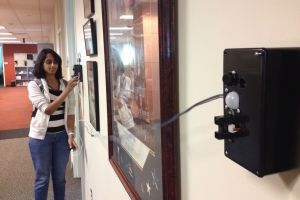 |
This project will bring together the static (e.g., sidewalk condition, street networks, characteristics of land use) and dynamic (e.g., traffic volumes, weather, and light quality) characteristics of the environment that are monitored close to real time into one decision support system for route planning. 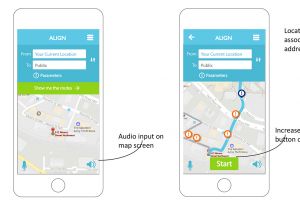 |
|
Lacking information provided about airport environments and route conditions makes it difficult for air travelers to plan indoor trips at airports and anticipate possible environmental barriers, which could lead to navigation difficulties. An application that provides real-time environmental information has been designed to facilitate trip planning at airports for travelers, especially those with functional limitations. In this project, we conducted a set of studies to define and further understand the problem of airport navigation and developed a mobile application as the solution. 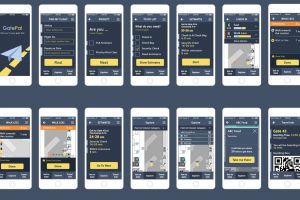 |
A majority of individuals diagnosed with multiple sclerosis (MS) experience a significant decline in their abilities due to the progression of MS after five years post-diagnosis. Following this period, they need to learn how to cope with the functional limitations caused by the disease and how to age with MS. They must manage effects of the disease on their lives on a daily basis. Self-management activities can help with this challenge.  |
The needs and abilities of people who are aging with progressive chronic conditions, such as MS, Parkinson's, ALS and Arthritis fluctuate from day to day. Yet, even when they have supportive AT, such as grab bars, to compensate for functional limitations, those features are fixed, only able to support some abilities, some of the time. The purpose of this project is to develop a SmartBathroom environment capable of assessing an individual's abilities at any point in time and spontaneously adjusting supportive environmental features to accommodate those abilities. |
This is a collaboration with our industry partner The Home Depot seeking to optimize the current curbside process from the associate perspective. |
|
The internet, mobile, and social media technologies have been successful in connecting large segments of the world's population, generating wide access to global networks of information. There are several clusters of unconnected/under-connected populations across the world, however, who do not have access due to financial, social, or political limitations. |
Juvenile idiopathic arthritis (JIA) is the most common cause of chronic childhood arthritis, affecting 1 in 1000 children. 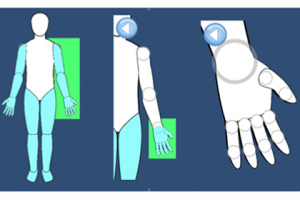 |
This project aims to ensure that the dignity of a Parkinson's patient is maintained during interactions with caregivers using a robot as a co-mediator. The mediator will hold a mental representation of the patient's and caregiver's emotional state and react accordingly. The co-mediator will express the patient's internal emotional state through spatial and emotive gestures. 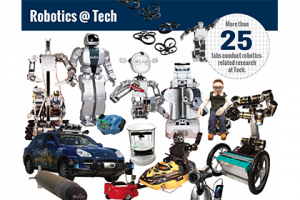 |
We are creating a platform for experiencing room-scale augmented reality through head-mounted displays. Prototypes will involve various tracking methods to interpret the user's gestures and movements. |
|
The Responsive Objects, Surfaces, and Spaces (ROSS) API is a way for tangible applications to operate seamlessly across a variety of tangible input devices and platforms. It allows applications to exchange information about the devices they are running on and obtain real-time data about tangible and touch interactions with other devices. In a ROSS world, you can use your mobile phone as a controller to play games on the digital coffee table in your living room; and your guests can join in with their phones too. 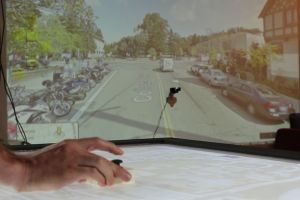 |
Large, multisensor datasets are available covering a large portion of Mars. Analysis and display of these datasets are currently in use for path planning tools that provide a precise, low-level visualization that fosters precision planning for Rover Planners at NASA Jet Propulsion Laboratory. However, these visualizations do not foster path planning at a higher level of abstraction. In addition, planning a path uses a non-intuitive process of generating rover commands, simulating them, visualizing the results, and then tweaking the commands until the path looks correct. 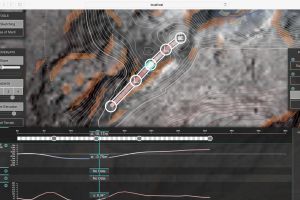 |


